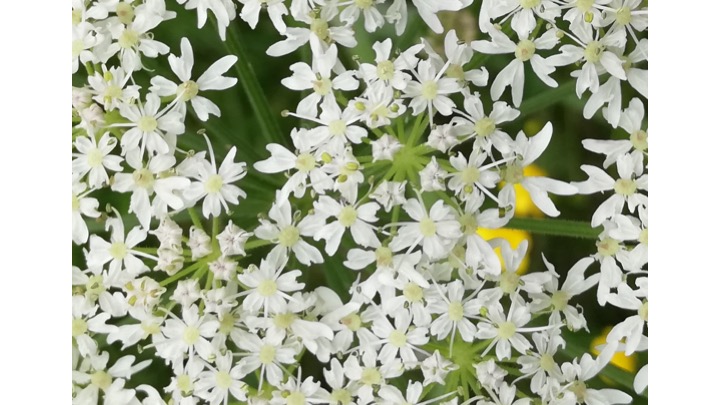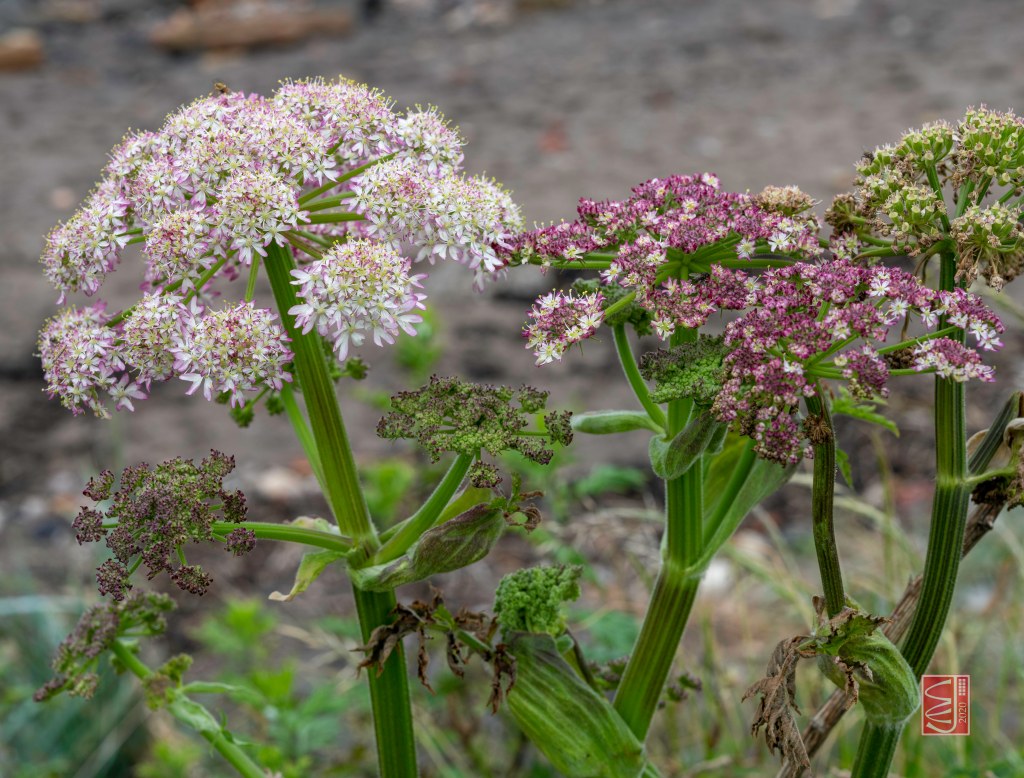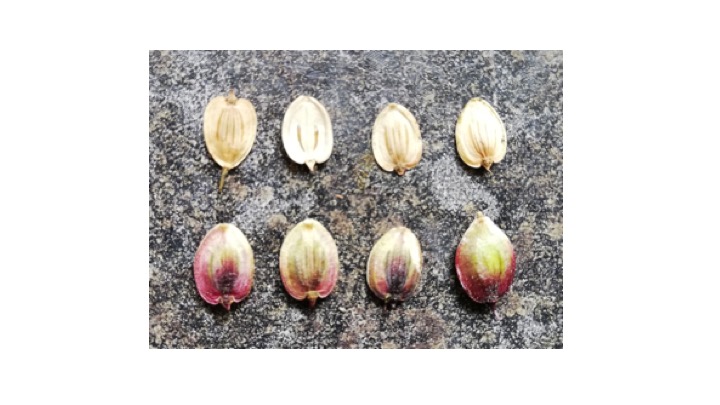
By Roger West
This is a member of the family Apiaceae (formerly Umbelliferae, because the flowers of all species are borne in umbels) until botanical correctness made all family names end in -aceae. It still retains the Latin name bestowed upon it by Linnaeus. The genus name Heracleum derives from the Greek “herákleion” and refers to the mythologic hero Heracles, who is reputed to have used the plant medicinally. The species name sphondylium, meaning “vertebrae”, refers to the shape of the segmented stem. A detailed biology of the species is in Sheppard (1991).

It is native to the British Isles where it is one of the commonest members of its family. It grows in “grassy places, rough ground, roadsides and banks” (Clive Stace, New Flora of the British Isles), and “is typical of fertile, clay-rich, alluvial-meadow-type soils (pH 6-7)”, is frequent on poorly grazed or infrequently mown neutral grassland, likes plenty of N, P and K, and can grow in quite dense shade in woodland (Sheppard 1991). It is easily seen, since it often displays its flowers at about waist height. The commonest subspecies in the British Isles, and the only one found in Scotland, is ssp. sphondylium (Velen.) Brummitt, and my notes below apply chiefly to this subspecies. It is described by Stace (2019) as having “Petals white or pinkish-white to purplish”, and is to be found from sea level to 1000 m (Sheppard 1991). The pinkish colour is presumably due to the presence of anthocyanins, which are made by almost all flowering plants. In the case of umbels that appear pink from a distance, the unopened flowers are quite a dark red, but the petals bleach as they open: in my experience, it is unusual (but by no means unknown) to find fully open flowers that are pinkish. The frequency and intensity of pink umbels varies from plant to plant, and from year to year: I think there may be a variable genetic propensity to pinkness, which is promoted by the weather during Spring. This year, the Spring weather must have strongly encouraged pinkness. H. sphondylium occasionally hybridises with Giant Hogweed, H. mantegazzianum, producing infertile offspring. A student dissertation on this hybridisation by Bailey Brown, appeared in BSS News 114, p.11.

Pollination biology: Sheppard 1991 mentions that Vespidae, Andrenidae, Halictidae and Apidae (Hymenoptera), Staphylinidae, Cantharidae and Cerambycidae (Coleoptera) are principal pollinators. A study in Poland (where subspecies of H. sphondylium occur that are not present in the British Isles) by Zych (2002) found that H. sphondylium ssp. sphondylium is visited frequently by Dipteraand Hymenoptera, but that only 21 of 40 taxa carried significant quantities of pollen. The Pollinator Importance Coefficient (IC) calculated for each insect group, and based on observation of insects’ abundance, within-umbel activity and pollen load revealed that only four taxa of insects (Thricops nigrifrons, Eriozona syrphoides, Meliscaeva cinctella and Arge ustulata) were important pollinators of H. sphondylium ssp. sphondylium. In another study, Zych (2007) found that two different colour subspecies (?) of H. sphondylium were visited by more than 108 insect species during two study seasons. Analysis of the insects’ importance suggested that the most efficient pollinators are the medium-sized flies Eriozona syrphoides, and Lucilia spp. (Diptera). Bumblebees Bombus terrestris (Hymenoptera), beetles of the genera Stenurella spp. and Dasytes spp. (Coleoptera) and flies Eristalis spp., Meliscaeva cinctella, Phaonia angelicae and Thricops nigrifrons also contributed to pollination of the studied plants, but their efficacy showed considerable seasonal variation. Flowers in the staminate phase were visited significantly more often than those in the pistillate phase. Some flower visitors visited the staminate phase only, which suggested they may be parasites rather than pollinators.

Biochemistry and toxicity: H. sphondylium contains furanocoumarins. These are carcinogenic, mutagenic and phototoxic. They are biosynthesised by plants in the Apiaceae, mainly to protect themselves from fungal parasites. At high concentrations they cause phytotoxicity. They are most concentrated in the plant’s roots and fruits. In the green parts, psoralen (the parent compound of furanocoumarins) has been found to be most concentrated in the outer regions of the plant’s stem. They are present in high concentrations in H. mantegazzianum, but in H. sphondylium they are present in such small quantities that, like cultivated celery (Apium graveolens var. dulce, the type genus of the Apiaceae, it is safe to eat, and there are those who esteem it as food. If you collect H. sphondylium for food you should, therefore, be quite sure of the identification, and that the plant is not a hybrid with H. mantegazzianum, otherwise you could be in for very unpleasant illness.
There are two different types of secretory structures in the fruits, producing different lipophilic compounds. The canals, present in all of the aerial vegetative plant parts and in the fruits, are characterized by mono- and sesquiterpenoids, while the vittae, peculiar to the fruits, contain fatty acid aliphatic esters and furanocoumarins. Antibacterial compounds, effective against eight types of bacteria, were found in ethanolic and aqueous extracts of H. sphondylium ssp. artivinense, and may also be present in ssp. sphondylium. (Bicchi et al. (1990))
Eating hogweed: There are those who esteem H. sphondylium as food. I garnered the following eulogies from the Internet:
“Talk about giving a plant a bad name! The hogweed (Heracleum sphondylium) in my garden is neither a weed nor for the hogs: it is a valued vegetable. … The tastiest way of eating them is to sauté them in butter until they develop a melting texture and a slightly caramelised taste.”
“Cooked like spinach, hogweed has a flavour of its own. One of the best tasting of the wild foods available in the UK. The shoots are best blanched and cooked in butter, the leaves can be used when very young or as a flavouring for soups and stews, the flower buds can be used like broccoli, the seeds are a direct replacement for cardamom and the roots can be used like parsnips but must be boiled well. Only the young leaves should be eaten before they open out fully.”
“I have now fed it (well fried, almost to caramelisation) to several hundred people with no adverse reactions reported. In fact, I’ve had more people not get on with chanterelles than common hogweed. I did have one experienced forager at the weekend who declined to taste the seeds, having experienced some tingling in his mouth from tasting them in the past. I wonder if the effect may be cumulative in some people? I eat loads and haven’t developed any reaction”.
Richard Milne mentioned H. sphondylium as food in his article Foraging in Craigmillar Park 6th May 2019 in BSS News 114, p.32.
However, on the Internet, there was a warning on collecting the plant: “Gloves should be worn as a few people can find they get an allergic skin reaction when in regular contact with the sap rather like Giant Hogweed but nowhere near as severe.” The same problem may affect people, such as harvesters and packers, who come into frequent contact with celery.
Medicinal Uses: The Internet tells me that “Hogweed oil was used as a sedative and expectorant.” and that “[H. sphondylium] was once employed in medicine, although its use has been long out of favour. Long ago the seeds were boiled in oil that was then recommended for application to running sores and to treat the rash associated with shingles. Culpeper recommended a decoction of the seeds to be applied to running ears.”

References:
Bicchi C., D’Amato, A., Frattini, C., Filippin, R. (1990) “Chemical diversity of the contents from the secretory structures of Heracleum sphondylium ssp. sphondylium”. Phytochemistry, 29(6), pp.1883-1887 https://doi.org/10.1016/0031-9422(90)85033-C
Sheppard, A.W. (1991) “Heracleum sphondylium L.”, Journal of Ecology, 79, 235-258.
Stace, C (2019) New Flora of the British Isles ed. 4 (p.864), C & M Floristics, Middlewood Green, Suffolk, U.K.
Zych, M. (2002) “Pollination biology of Heracleum sphondylium L. (Apiaceae): the advantages of being white and compact”, Acta Societatis Botanicorum Poloniae, 72(2)
Zych, M. (2007) “On flower visitors and true pollinators: The case of protandrous Heracleum sphondylium L. (Apiaceae)” Plant Systematics and Evolution 263, 159–179.